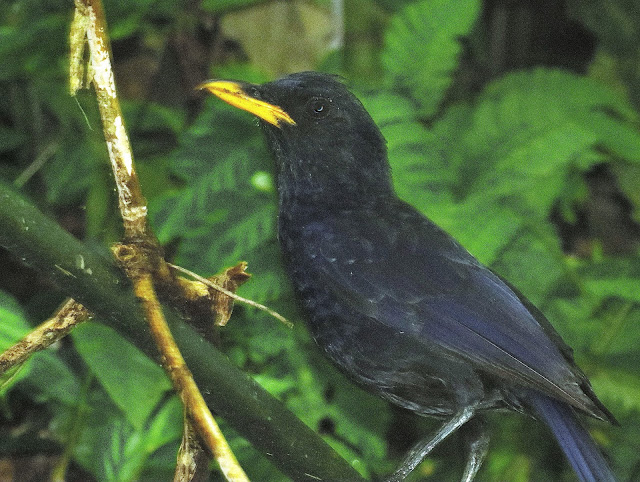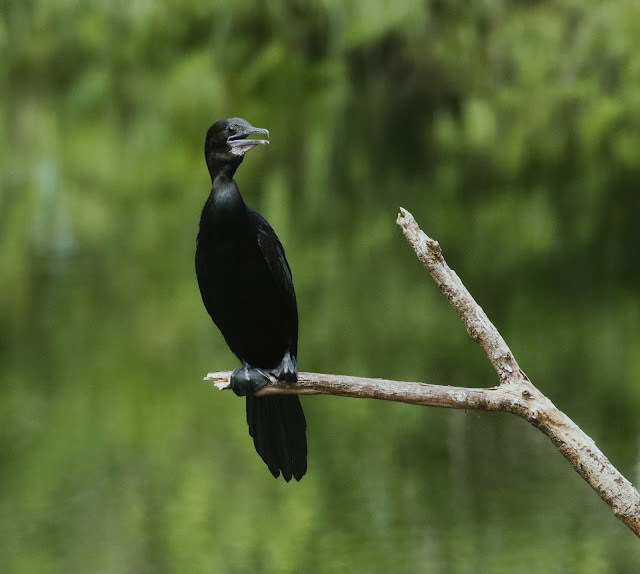It has been almost 10 months since my last shorebirds survey trip. So I am very glad to be back in action. This time I join a group of 'new' birders to this shoreline. Naturally at this time of the year, the newly arrived birds are still having their colourful breeding plumage and they didn't disappoint us.
Tibetan Sand Plover with a Red-necked Stint
Anarhynchus atrifrons & Calidris ruficollis
Tibetan Sand Plover
Anarhynchus atrifrons
Apparently there are two types of 'Lesser Sand Plovers' which have been separated as two distinct species of their own. One of them is the above. Majority of the waders seen here were from this group/species (A.atrifrons).
Anarhynchus atrifrons
Some of them are still very much in their breeding plumage.
The other one which Dave Bakewell described as "having shorter, more blunt-tipped bill and slightly shorter legs. In flight, looks long-winged; white wingbar is typically less extensive than on other sand plovers" is the Siberian Sand Plover (Anarhynchus mongolus) of which is reported not being seen in Malaysia as yet ! Note: All the above Sand Plovers are Tibetan Sand Plovers and the blurry one in the foreground is actually a Broad-billed Sandpiper and the other two on the most left are Curlew SP.
Initially I thought this Plover might fit the description of a Siberian Sand Plover but experts say nope.
Here's another one.
It appears like one of those A. mongolus race of Stegmanni.
Naturally the most attractive ones will be those with their red hot plumage and none is more prominent than the ones shown by the Curlew Sandpiper.
Speaking of plumage, I found out a word called 'Transitional Plumage' which the literature described as "the temporary feather condition when a bird is molting between its non-breeding (basic/winter) plumage and breeding (alternate/summer) plumage". During this transition process, their feathers will look like the above bird - 'patchy', 'scruffy', 'smudgy' and 'oddly patterned'. Scroll further down to learn more about their plumage terminologies.
Here are a few more photos showing the various 'transition' plumage of some Curlew Sandpiper.
It looks like having speckles of jewels on its back.
Ruddy Turnstone
(Arenaria interpres)
They are actually common but their numbers are only a handful here. That makes them one of those a must-see shorebirds.
Ruddy Turnstone
(Arenaria interpres)
In flight
Ruddy Turnstone
(Arenaria interpres)
In this trip, I only saw four of them.
Broad-billed Sandpiper
(Calidris falcinellus)
Here's another wader which population has probably reduced. I only saw three at this site.
We also saw these duck-liked waders 😃
Terek Sandpipers
Xenus cinerues
Their numbers are just slightly more than those of Broad-billed Sandpipers
This is probably the third largest number of waders seen at this site after the Tibetan Sand Plovers and Curlew Sandpipers.
Red-necked Stint
Calidris ruficolis
They are always at the forefront if you see them together with flock of mix waders.
Red-necked Stint
Calidris ruficolis
Red-necked Stint
Calidris ruficolis
Only a small number of them are showing their summer plumage.
Red-necked Stint
Calidris ruficolis
Calidris ruficolis
Tibetan Sand Plover
Anarhynchus atrifrons
Charadrius mongolus atrifrons (previous scientific name)
Juvenile
Tibetan Sand Plover
Anarhynchus atrifrons
Charadrius mongolus atrifrons (previous scientific name)
Juvenile
Another juvenile.
Tibetan Sand Plover
Anarhynchus atrifrons
Charadrius mongolus atrifrons (previous scientific name)
To appreciate more the beauty of these shorebirds, one can dive deeper into their plumage formation. Here are a few common terminologies in the avian literature which describe the various formations. I hope I am able to show them in a pictorial form.
Once the juvenile birds reached their 2cy/adult staged, their feathers will then transit into their pre-alternate plumage.
Pre-alternate plumage - usually occurs before breeding season whereby the feathers will eventually become their alternate plumage which is actually their breeding plumage. There is also another term which is called a partial pre-alternate plumage which involves only some partial feather replacement. Unfortunately I am not able to find any suitable or rather reliable photos to depict this moult.
Note: in Dave Bakewell's gospel, the correct term to describe the above bird should be that it is undergoing a Pre-alternate moult which will eventually leads to its alternate plumage.
Also note that because these post and photos here were taken in the month of August, the above bird is actually still in its alternate plumage.
Here is a Tibetan Sand Plover showing its breeding / alternate plumage.
After breeding season, the waders' feathers will then moult into a 'Pre-basic Plumage'.
Pre-basic plumage usually occurs after breeding season whereby their feathers will eventually moult into basic/winter plumage.
Note: in Dave Bakewell's gospel, the correct term to describe the above bird should be that it is undergoing a Pre-basic moult which will eventually leads to its basic/winter plumage.
Coincidentally this Curlew Sandpiper was also seen at Kapar and I believe this same bird could have also visited the same area in 2024. It is probably not seen by the shorebird spotters.
Here are a few flight photos. Most of them were taken from a distance.
Red-necked Stint
The above photo is like taken in the winter 😊
Here is a mix flock.
Only two common species though.
Lesser Adjutant
A resident stork which hardly can be seen up North like in TAT.
Here is something different. Not easy but I manage to get a shot of a jumping 'fish' !
It's a Gold-spotted Mudskipper
Periophthalmus chrysospilos
Gold-spotted Mudskipper
Periophthalmus chrysospilos
Apparently this mudskipper is common in this region.
THAT'S ALL FROM THE MUDFLATS !
HAVE A GREAT TIME !



























































